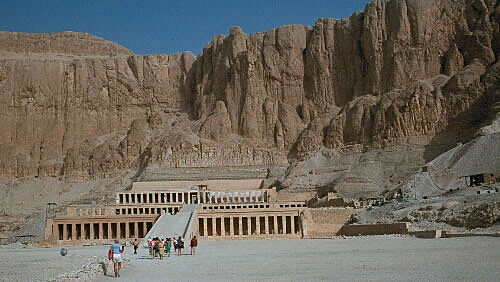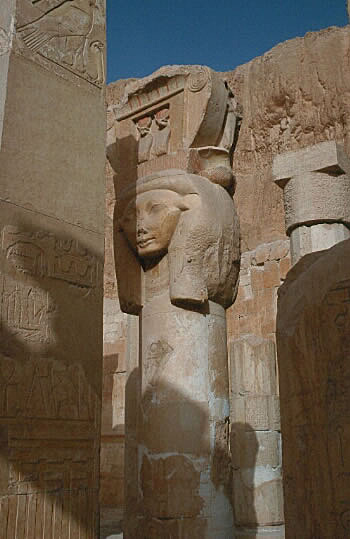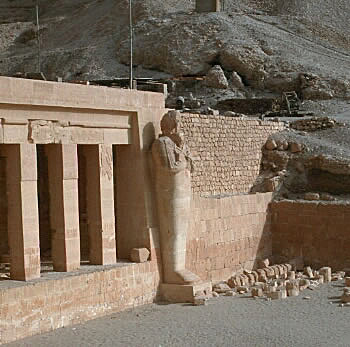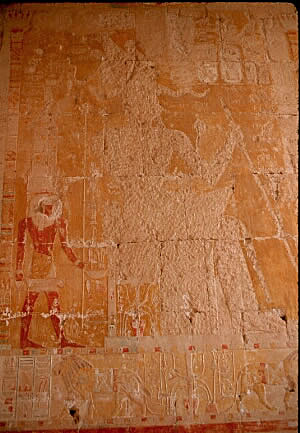 |
|
Deir El-Bahari has to be one of the most interesting monuments in Egypt today. As you approach it from the distance it is as if you are looking at a modern building that has been carved out of a stone mountain. Its choice of location and its architecture are superb. Imohotep is perhaps the best known architect from the ancient period, however, Senmut, 1250 years after Imohotep, gained his place in history as the architect of Deir El-Bahari. Dier El-Bahari was commissioned by Queen Hatshepsut as a funerary monument to honor her father, Tutmose I and herself. She chose the location, a valley that had already been consecrated to the goddess Hathor but abandoned.
|
|||
|
The temple faces east and is nestled in front of a shear rock cliff that surrounds it in the shape of a fan. Consisting of a series of vast terraces accessed by large ramps. The ramp to the first level was lined with sphinxes and obelisks none of which remain today. A second ramp goes to the third level. Dier El-Bahari has, since the time of our visit in 1984, been undergoing a major restoration. The recent special on the History Channel (May 2001) showed what this monument looks like today and it is considerably improved. Many of the large stones used for the sides of the ramps were missing and have now been replaced by new stones, chiseled to the same measurements, from the same quarry. Anne and I can't wait to visit and see the restored Dier El-Bahari. |
|||
 Dier El-Bahari showing the 1st and 3rd tiers (notice you seen nothing of the second tier and its ramp leading to the third tier) |
As you can see in the photo left, the closer you got to the monument the more evident the destruction appears. Inside the monument there are a series of bas-reliefs that depict the birth and childhood of the queen and of her expedition (believed) to the center of the African continent. | ||
|
|
|
||
| Hatshepsut was an 18th dynasty pharaoh, one of a few female rulers of Ancient Egypt and the longest ruling female. Hatshepsut was the daughter of Tutmose I and Aahmes, both royal descendants. When her two brothers died she was left in the unique position to ascend to the throne. A half-brother, Tutmose II, a son by a commoner, technically ascended to the throne, however, it is believed that Hatshepsut controlled him for his short reign. Typical of the Egyptian Royalty, Hatshepsut and Tutmose II, her half-brother, were married. Tutmose II suffered from some disease and died after ruling just four or five years. Hatshepsut and Tutmose II had no offspring, however, she had a daughter, Nefrure, believed to be fathered by Senmut the architect of her great temple; Tutmose II had a son, Tutmose III, with the commoner, Isis. | |||
|
On Tutmose II's death his son by Isis was in line for the throne, however, he was a small child. Hatshepsut was allowed to reign in his place as a queen dowager. It is said that Hatshepsut was a charismatic and beautiful lady and not prone to sitting back and waiting for her young nephew to age and take the throne. She quickly garnered a large following and took control as pharaoh and ruled for 20 years until her death in 1458 B.C. Over the years of her rule Tutmose III became very bitter and resentful of her having taken his place on the throne. Hatshepsut's lover, Senmut, was originally to be buried in the tomb he designed for Hatshepsut, but was actually buried in his own tomb nearby. At her death, it is believed Tutmose III began a campaign to rid Egypt of any memories of Hatshepsut and her lover. His tomb was destroyed along with his sarcophagus. His funerary coffin was found crumbled into more than 1,200 pieces and his mummy never found. Hatshepsut's remains suffered the same fate. Tutmose III ordered that all mention of her be erased from every temple and monument in Egypt. The photo (above right) shows where Hatshepsut likeness has been chiseled out of the stone. He ordered her name be removed and replaced with the name of Tutmose I, II or III. It is not known whether or not Tutmose III killed Queen Hatshepsut but many believe he did. Next stop ... Valley of the Kings
|
|||



